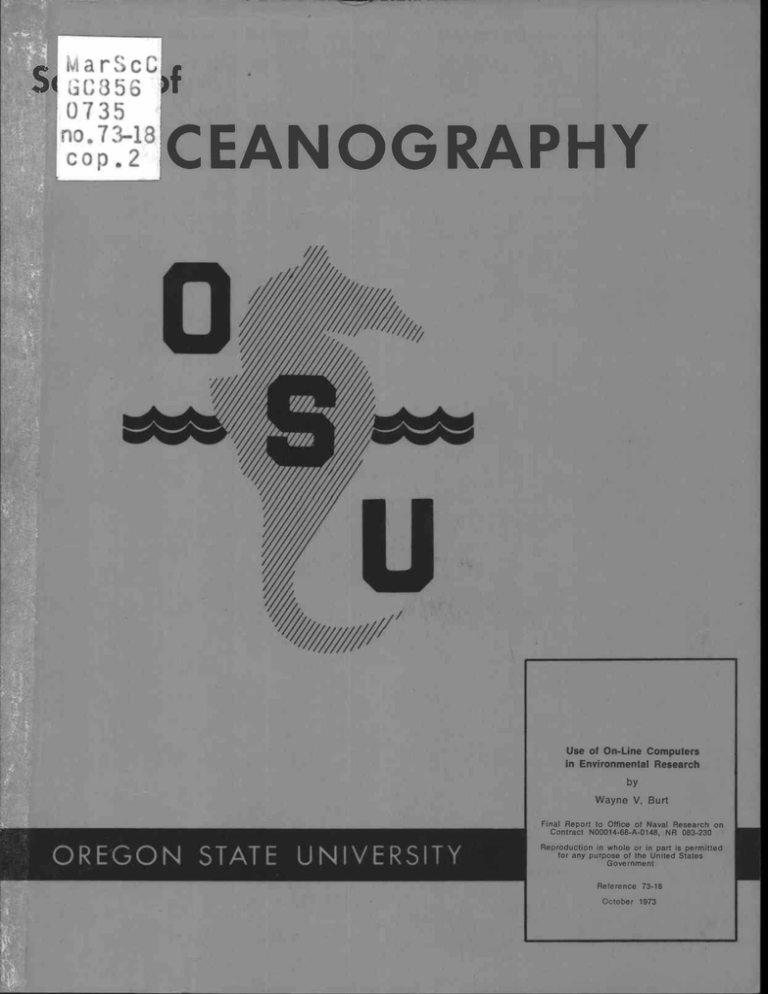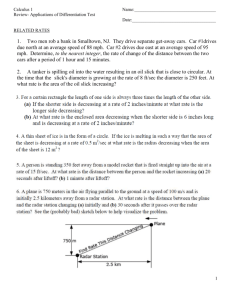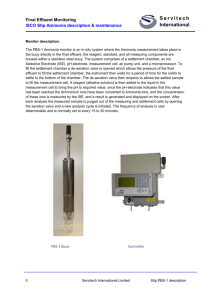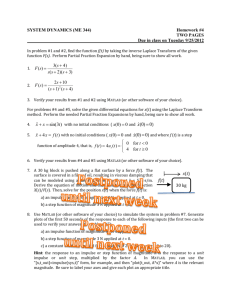NUGRAPH E S '4
advertisement

S fWIdF-iL:11 r .64 'IC356 '4 I"O735 o 7, -._ r._ C, t p, E NUGRAPH 57 04. H c q Use of On-Line Computers in Environmental Research by Wayne V. Burt Final Report to Office of Naval Research on Contract N00014-68-A-0148, NR 083-230 GREG No STATE UNIVERSITY Reproduction in whole or in part is permitted for any purpose of the United States Government Reference 73-18 October 1973 R. _v_ If School of Oceanography Oregon State University Corvallis, Oregon 97331 USE OF ON-LINE COMPUTERS IN ENVIRONMENTAL RESEARCH By Wayne V. Burt Final Report to the United States Office of Naval Research on Contract N00014-68-A-O148 NR 083-230 Approved for Public Release; Distribution Unlimited Reference 73-18 October 1973 John V. Byrne Dean ABSTRACT A real-time data acquisition/central system has been developed for environmental monitoring and research. The basic elements of the system are a large instrumented spar buoy, a computer which controls data acquisition through a telemetry link and simultaneously files and analyzes the data, and the investigator who prescribes appropriate sets of computer operations. The system has particular advantages for real-time operational decision making and for nonstandard environmental investigations. INTRODUCTION The research reported here has been directed toward real-time computer applications to oceanic and atmospheric data gathering, processing and analysis. Four primary elements are included in this research: a) source of measurements, b) real-time transmission to and from a computer facility, c) a computer facility, and d) software that produces readily usable outputs. Fundamentally, these elements constitute a closed-loop measurement/analysis system which includes a man who can make decisions that influence further measurements and analyses. Sources of measurements are the Totem spar buoys; they are 160 feet long, can support a 2000 lb. load above water and are moored by a four-point system. The paramenters measured include wind speed and direction, air and water temperatures, atmospheric pressure, rainfall, wave height, current speed and direction and solar radiation. The full-duplex digital transmission system is conventional and uses off-the-shelf components, plus a computer interface. The computer facility includes a DEC PDP-15 computer with added core storage and peripheral equipment. The software library includes programs for statistics, time series analyses and graphical display, as well as software for data acquisition and system control. 2 BUOY STRUCTURE AND SCIENTIFIC INSTRUMENTATION The Totem buoy structure and 6 feet in diameter. by flooding ballast Totem structure, is a spar 160 feet long quasi-cylindrical station The buoy is towed to tanks, and moored by a four point system. ment is reports Adequate room for navigational aids and data acquisition and telemetry equip- provided by a two-story one-sixth the spar length shelter provides a on top of the spar. stable platform for Atop a tower ten feet above the shelter mentation. erected Details of mooring and deployment are subjects of separate (Dominguez and Nath, 1969; Young and Neshyba, 1970). power supplies, horizontally, Freeboard of scientific instru- roof and forty feet above sea level are the meteorological instruments which monitor air temperature, barometric pressure, solar direction. At the (wave staff) are monitored are operational) rainfall and wind speed and mean water level sea surface temperature and elevation monitored. Water temperature and current speed and mounted instruments at depths by boom below mean water radiation, level. A Yo-Yo system of 7, 15, and 36 meters was installed (but did not become that would allow, by command temperature, conductivity direction from the data center, profiles of and current speed and direction to be obtained. DATA ACQUISITION - TELEMETRY SYSTEM Data acquisition is controlled by a PDP-15/30 computer under the direction of the investigating scientist. The link between the data center and buoy, a distance of some 90 miles, is via a 600 bit per second VHF/UHF radio data link. The available rate to 40 band width of this link limits the data acquisition samples per second using 12 bit data words. The computer will sample any desired parameter at a rate specified by the investigator and store the data in the computer system or graphically display it if the 3 scientist desires to examine it. The PDP-l5/30 computer, a foreground background machine, can also simultaneously process the raw data through mathematical or statistical routines into a form desired by the scientist. The results of analysis can thus be presented to the scientist in any format desired in seconds after the observations are analysis/display existing enables. conditions; made. This real time control/ the scientist to adjust his sampling rate to meet it thereby removes the constraint of having to guess the needed sampling rate and then having to wait until the experiment is, terminated to learn if the experimental design was appropriate. Also, as the status of the data collection system is known in real time, malfunctions can be rapidly corrected so as to minimize data loss. The data acquisition system has 64 analog data channels which are digi- tized at the buoy, continuous analog 32 digital input channels, 32 command channels and 3 channels. These data acquisition subsystems are described below. The analog data subsystem has 64 analog inputs which are multiplexed to a 12 bit 0 to 10 volt analog-to-digital converter. Each input to the system is conditioned in a separate integrated in the system, circuit, board located internally conditioning the input signal into the format needed by the analog-to-digital converter. Changing the function of any one of the 64 channels thus simply involves replacing a circuit board. The digital input subsystem has 32 digital inputs which accept words 12 bits in length. Eight of the 32 channels are permanently assigned to the Yo-Yo which is a winch-lowered sensor probe. 4 The command subsystem acts as the control center for the buoy system. It decodes 32 computer commands into properly sequenced control signals to control the buoy sub units. winch, Among the devices controlled are the Yo-Yo motor-generator, system power, and the buoy transmitter. The three analog channels are for continuous transmission of data and have a cutoff of approximately 2 Hz. These channels were included in the system to obtain long data records without bogging down the remaining system, thus enabling simultaneous taneously with the. experiments. These channels can operate simul- higher speed data acquisition system. The system's design is modular, permitting investigators to attach instrument to the system by inserting a printed circuit board. be noted that all components an optional an It should of the system can operate simultaneously and voice link exists for system maintenance and check out. COMPUTER FACILITY The computer facility serves two control, functions; data acquisition and system and data reduction and anlysis. Data gathering and system control require less than 0.1% of the computer's time. To alleviate this waste of computer power the machine is so programmed that it can run a data reduction or an analysis program simultaneously with the data acquisition system. The computer "jumps" in and out of the data acquisition program portion upon receiving an external interrupt once every second. Because of data acquisition program takes so little of the computer's time, the scientist who is running a data reduction or analysis program never realizes that the buoy data acquisition system is running simultaneously. The computer automatically interrogates the buoy system at standard intervals (ten minutes) and approximately one-half month of this routine data can be 5 stored on special a single DEC buoy functions initial function tape. or observations effectively functions minutes. every three hours at He would obtain or observation the initial time is set to deleting it as teletypes, the system has absolute Available output line time for the wave statistics minutes after collecting each data set. plots within Thus the scientist include in an initial taking wave staff measurements second intervals for ten a buoy function by typing For example, the scientist can follow wave development during a storm by automatically and spectral can initiate a sequence of or observation and the desired time interval between or observations. one-tenth The scientist runs on the To delete 400 days, thus standard 365-6 day year. control of the buoy via the computer. devices to the scientist for displaying the data a high speed paper tape punch, 4 DEC printer, and a Tektronix 4002 graphic tape drives, a display terminal. SOFTWARE Software functions include: buoy control, computer peripheral hardware control, system checks, data acquisition-filing and data analysis. Standard data analysis programs for displays were developed. statistics, spectral analyses and graphical The basic spectral analyses routines detrend and filter time series and compute Fourier transforms, correlation functions and complex demodulates, as well as compute auto, cross and multivariate spectral density estimates (Ochs, et al, 1970 & 1971). These spectral routines are in modular form and have simplified the process of developing specialized routines for computation of ratary spectra, time-variable spectra, air-sea transfer functions, spectra of gappy series and stochastic predictions. 6 PUBLICATIONS RESULTING FROM THE TOTEM BUOY RESEARCH Burt, W. V., et al., 1973. region off Oregon. Crew, H. and N. Diurnal variations of winds over an upwelling Boundary Layer Meteorology. (inpress) Plutchak, ---. Time varying rotary spectra. Submitted to J. Ocn. Soc. Japan. spar Analysis of a two-point mooring for a R. and J. H. Nath, 1969. Domingues, Oregon State University, Dept. Oceanography, Ref. 69-34. buoy. Elliott, W., R. Egami and G. Rossknecht, 1971. Rainfall at sea. Nature. 299 (5280), 108-109. et al. 1970. Gilbert, K. , Oregon State Herr, A. J. Univ., Data from THEMIS moored instrumented ocean array. Dept. Oceanography Data Report 43, Ref. 70-25. Oceanographic and meteorological remote sensing buoy 1971. IEEE '71 Eng. in the Ocean Environment Conf. system. Nath, J. H. and S. Neshyba, 1971. Two-point Oceanol. Int. Ochs, L., et al. Volumes 1 , 364-368. mooring system for spar buoy. J. Waterways, Harbors and Coastal Engr. Div., Neshyba, S., D. Young and J. Nath, 1970. Proc., ASCE, 97(WW2), 295-312. Moored spar buoys for ocean research. 5 (4), 22-26. 1970,71. OS-3 ARAND SYSTEM: and 11. documentation and examples. Oregon State Univ., Computer Center, Ref. CCR-70-4 and CCR-71-1. Plutchak, N.B., 1972. 1970 TOTEM wind and current data. Oregon State Univ. Dept. Oceanography Data Report 52, Ref. 72-13. Reed, R.K., 1973. Rainfall over coastal waters of the Pacific Northwest. Oregon State Univ., School of Oceanography, M.S. Thesis. Sakou, T., 1970. motion. Inertial period oscillation in response to local atmospheric La Mer. 8 (4) 235-238. 7 Sakou, T. and S. Neshyba, 1972. The temporal structure of oceanic motion off the Oregon coast, Northeastern Pacific, 1969. J. Mar. Res., 30 (1), 1-14. Vithayathil, F., 1972. Analog hybrid simulation of Ekman's drift equations. Oregon State Univ., Dept. Vithayathil, Oceanography. File Report (1972) Simulation of wind-driven currents off the Oregon F., coast with a hybrid Ekman drift mode. Oregon State Univ., Dept. Elec. Engr., Ph.D. dissertation (in preparation). Yao, N. ---. Bispectral and cross-bispectral analysis of wind and currents off,the Oregon coast. Oregon State Univ., School of Oceanography, Ph.D. dissertation (in preparation). Young, D. and S. buoy. Neshyba. 1970. Engineering design and usage of the TOTEM Oregon State Univ., Dept. Oceanography, Ref. 70-19.. SECURITY CLASSIFICATION OF THIS PAGE (When Da:a Entered READ INSTRUCTIONS BEFORE COMPLETING FORM REPORT. DOCUMENTATION PAGE I.. REPORT NUMBER 2. GOVT ACCESSION NO. 3. RECIPIENT'S CATALOG NUMBER 5. TYPE OF REPORT & PERIOD COVERED 6. PERFORMING ORG. REPORT NUMBER S. CONTRACT OR GRANT NUMBER(@) 73-18 4. TITLE (and Subtitle) Use-of On-line Computers in Environmental Final Report Research 7. AUTHOR(s) N000 14-68-A-0148 Wayne V. Burt 9. PERFORMING ORGANIZATION NAME AND ADDRESS 10. School of Oceanography PROGRAM ELEMENT, PROJECT, TASK AREA & WORK UNIT NUMBERS N R 083 - 230 Oregon State University, Corvallis Oregon 97231 It. CONTROLLING OFFICE NAME AND ADDRESS 12. .Office of Naval Research Ocean Science and Technology Division REPORT DATE October 1973 13. Arlin ton VA 22217 4. MONITORING AGENCY NAME A ADDRESS(!f different from Controlling Office) NUMBER OF PAGES 7 15. SECURITY CLASS. (of this report) unclassified ISa. DECLASSIFICATION DOWNGRADING SCHEDULE 16. DISTRIBUTION STATEMENT (of this Report) Approved for public release; distribution unlimited 17. DISTRIBUTION STATEMENT (of the abstract entered In Block 20, if different from Report) I11. SUPPLEMENTARY NOTES 19. KEY WORDS (Continue on reverse side If necessary and identify by block number) spar buoy, environmental monitoring computes data acquisition 20. ABSTRACT (Continue on reverse side It necessary and Identify by block number) A real-time data acquisition/central system has been developed for environThe basic elements of the system are a large instrumented spar buoy, a computer which controls data acquisition through a telemetry link and simultaneously files and analyzes the data, and the investigator who prescribes appropriate sets of computer operations. The system has particular advantages for real-time. operational decision making and for nonstandard environmental investigations.. mental monitoring and research. FORM DD I J AN 73 1473 EDITION OF I NOV 65 IS OBSOLETE S/N 0102-014-66011 SECURITY CLASSIFICATION OF THIS PAGE (When Data Entered)






